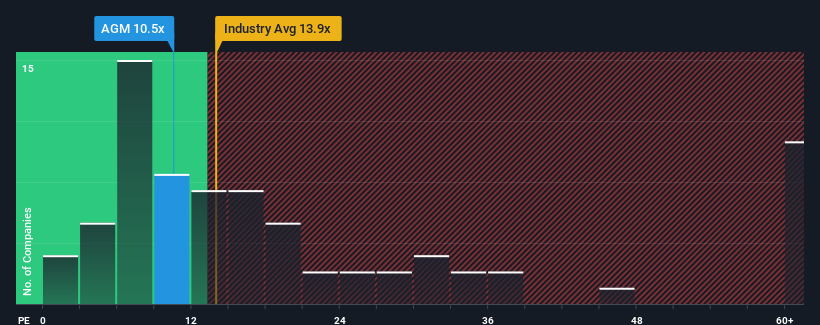- United States
- /
- Diversified Financial
- /
- NYSE:AGM
The Market Doesn't Like What It Sees From Federal Agricultural Mortgage Corporation's (NYSE:AGM) Earnings Yet

Federal Agricultural Mortgage Corporation's (NYSE:AGM) price-to-earnings (or "P/E") ratio of 10.5x might make it look like a buy right now compared to the market in the United States, where around half of the companies have P/E ratios above 17x and even P/E's above 30x are quite common. However, the P/E might be low for a reason and it requires further investigation to determine if it's justified.
Federal Agricultural Mortgage's earnings growth of late has been pretty similar to most other companies. One possibility is that the P/E is low because investors think this modest earnings performance may begin to slide. If you like the company, you'd be hoping this isn't the case so that you could pick up some stock while it's out of favour.
View our latest analysis for Federal Agricultural Mortgage

Is There Any Growth For Federal Agricultural Mortgage?
There's an inherent assumption that a company should underperform the market for P/E ratios like Federal Agricultural Mortgage's to be considered reasonable.
If we review the last year of earnings growth, the company posted a worthy increase of 4.0%. The latest three year period has also seen an excellent 60% overall rise in EPS, aided somewhat by its short-term performance. So we can start by confirming that the company has done a great job of growing earnings over that time.
Shifting to the future, estimates from the three analysts covering the company suggest earnings should grow by 8.1% each year over the next three years. That's shaping up to be materially lower than the 11% per year growth forecast for the broader market.
In light of this, it's understandable that Federal Agricultural Mortgage's P/E sits below the majority of other companies. Apparently many shareholders weren't comfortable holding on while the company is potentially eyeing a less prosperous future.
The Key Takeaway
We'd say the price-to-earnings ratio's power isn't primarily as a valuation instrument but rather to gauge current investor sentiment and future expectations.
We've established that Federal Agricultural Mortgage maintains its low P/E on the weakness of its forecast growth being lower than the wider market, as expected. At this stage investors feel the potential for an improvement in earnings isn't great enough to justify a higher P/E ratio. It's hard to see the share price rising strongly in the near future under these circumstances.
We don't want to rain on the parade too much, but we did also find 2 warning signs for Federal Agricultural Mortgage (1 shouldn't be ignored!) that you need to be mindful of.
Of course, you might also be able to find a better stock than Federal Agricultural Mortgage. So you may wish to see this free collection of other companies that have reasonable P/E ratios and have grown earnings strongly.
If you're looking to trade Federal Agricultural Mortgage, open an account with the lowest-cost platform trusted by professionals, Interactive Brokers.
With clients in over 200 countries and territories, and access to 160 markets, IBKR lets you trade stocks, options, futures, forex, bonds and funds from a single integrated account.
Enjoy no hidden fees, no account minimums, and FX conversion rates as low as 0.03%, far better than what most brokers offer.
Sponsored ContentNew: AI Stock Screener & Alerts
Our new AI Stock Screener scans the market every day to uncover opportunities.
• Dividend Powerhouses (3%+ Yield)
• Undervalued Small Caps with Insider Buying
• High growth Tech and AI Companies
Or build your own from over 50 metrics.
Have feedback on this article? Concerned about the content? Get in touch with us directly. Alternatively, email editorial-team (at) simplywallst.com.
This article by Simply Wall St is general in nature. We provide commentary based on historical data and analyst forecasts only using an unbiased methodology and our articles are not intended to be financial advice. It does not constitute a recommendation to buy or sell any stock, and does not take account of your objectives, or your financial situation. We aim to bring you long-term focused analysis driven by fundamental data. Note that our analysis may not factor in the latest price-sensitive company announcements or qualitative material. Simply Wall St has no position in any stocks mentioned.
About NYSE:AGM
Federal Agricultural Mortgage
Provides a secondary market for various loans made to borrowers in the United States.
Established dividend payer and fair value.
Market Insights
Community Narratives




